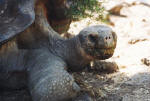The Giant Tortoise of Galapagos, Ecuador
Tortoises are land-dwelling turtles of the family Testudinidae (in Great Britain the name refers to any non-marine turtle), and are exclusively terrestrial, vegetarian reptiles. In folklore they represent slowness, determination, and long life. Though found in many parts of the world, the majority of the 40-odd living species are confined to Africa and Madagascar. They are characterized by high, domed shells; heavy, elephant-like hind legs; and hard-scaled forelegs. The common tortoise of southern Europe and the giant tortoises of the Galápagos and other islands are members of the genus Testudo. The common, or European, tortoise has a shell about 18-25 cm long, brownish in color, marked with black.
The giant tortoises are now rare or extinct on many islands because they were slaughtered and their habitats destroyed by man and because of the introduction of animals (pigs, goats, rats, etc.) that prey on the young or compete with the adults for food. Of the giant tortoises native to about 30 islands in the Indian Ocean, all are extinct except the group native to South Aldabra Island. The 10 to 15 Galápagos tortoises, commonly considered races of the species Geochelone elephantopus, are depleted and, in several cases, extinct. Giant tortoises attain very large sizes relative to most other living turtles. One captive Galápagos tortoise had a shell length (measured along the curve) of about 1.3 m (4.25 feet) and a weight of about 140 kg (300 pounds). Weights of about 180 kg have been recorded for specimens from Santa Cruz Island. [- Encyclopedia Britannica 2004]
The most famous giant tortoise of Galápagos is Solitario Jorge (Lonesome George), who, for many decades, has been the last surviving member of his sub-species, a fact that evokes lots of tearful empathy from modern visitors to the islands. A $10K bounty has been offered to zoos to furnish his kind of female. Kept at a research station in Puerto Ayora, he has so far rebuffed all potential mates from other sub-species. Given that a giant tortoise's lifespan averages 150 years or so, Solitario Jorge, now in his 80s, has limited time left to pass on his genes.
 |
 |
 |
 |
The most celebrated naturalist, writer, and observer of these animals was Charles Darwin, who visited Galápagos in the 1830s and where he did a good deal of the foundational work and data collection that went into his revolutionary work, The Origin of Species. Below is an excerpt from the field notes he kept on his extraordinary five-year journey, The Voyage of the Beagle (1831-36). As I was walking along, I met two large tortoises, each of which must have weighted at least two hundred pounds: one was eating a piece of cactus, and as I approached, it started at me and slowly stalked away; the other gave a deep hiss, and drew in its head. These huge reptiles, surrounded by the black lava, the leafless shrubs, and large cacti, seemed to my fancy like some antediluvian animals. The few dull-coloured birds cared no more for me, than they did for the great tortoises. The Beagle proceeded to Charles Island. This archipelago has long been frequented, first by the buccaneers, and latterly by whalers, but it is only within the last six years, that a small colony has been established here. The inhabitants are between two and three hundred in number ... nearly all people of colour ... banished for political crimes from the Republic of the Equator, of which Quito is the capital . although complaining of poverty, [they] obtain, without much trouble, the means of subsistence. In the woods there are many wild pigs and goats; but the staple article of animal food is supplied by the tortoises. Their numbers have of course been greatly reduced ... but the people yet count on two days' hunting giving them food for the rest of the week. It is said that formerly single vessels have taken away as many as seven hundred, and that the ship's company of a frigate some years since brought down in one day two hundred tortoises to the beach. ... I have already shown, from the numbers which have been caught in a single day, how very numerous they must be. Some grow to an immense size: [a man] told us that he had seen several so large, that it required six or eight men to lift them from the ground; and that some had afforded as much as two-hundred pounds of meat ... [In one region,] we lived entirely upon tortoise meat: the breast plate roasted (as the gauchos do carne con cuero), with the flesh on it, is very good; and the young tortoises make excellent soup; but otherwise the meat to my taste is indifferent. ... I was always amused when overtaking one of these great monsters, as it was quietly pacing along, to see how suddenly, the instant I passed, it would draw in its head and legs, and uttering a deep hiss fall to the ground with a heavy sound as if struck dead. I frequently got on their backs, and then giving a few raps on the hinder part of their shells, they would rise up and walk away; - but I found it very difficult to keep my balance. |
|||
Designed in collaboration with Vitalect, Inc. All rights reserved. |








